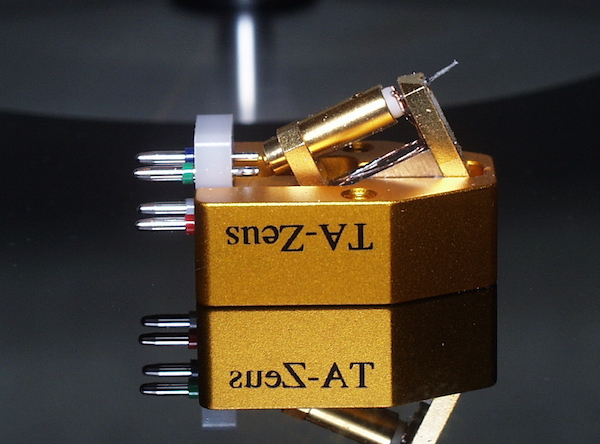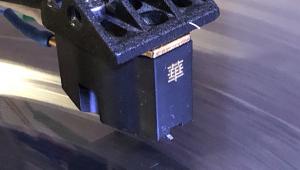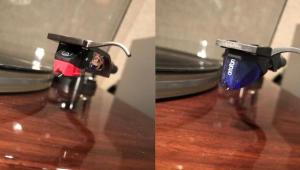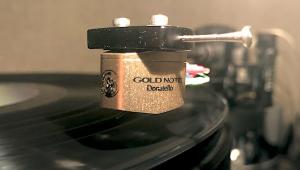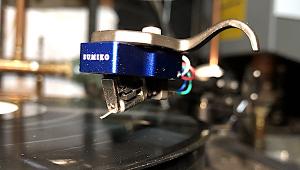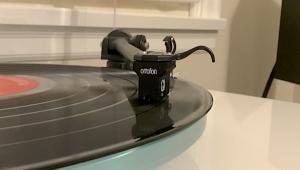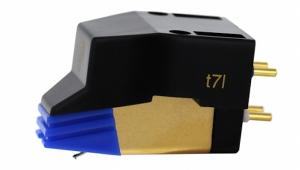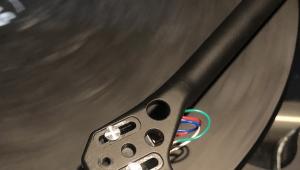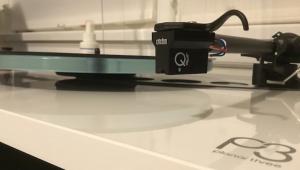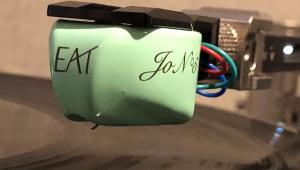Triangle ART Zeus MC Cartridge: The Best For Less?

Triangle ART also manufactures power line conditioners, cables and racks. The parent company KT Audio Imports distributes products manufactured by other companies. Designer/owner Tom Vu is a busy man!
Manufactured in Japan to to Triangle ART's specification, the Zeus features a familiar-looking solid diamond Micro-Ridge (3 µm x 70µm) stylus/.28mm Boron cantilever and coils of 6N copper (for those unfamiliar with the term "6N" means 99.999999 pure). Its electrical specifications include .3mV output (3.54cm/sec,1kHz) and 4 ohm internal impedance. Claimed frequency response is 10Hz-50kHz, channel separation of 30dB and <.5dB (1kHz) channel balance. Compliance is relatively low at 12x10-6cm/dyne and the cartridge is appropriately massive, weighing in at 11 grams.
The body, finished in a satiny gold is of an unspecified metal. The design is simplicity itself: the exposed "guts" are secured to a thick, heavy top plate, with the pole pieces, pipe, coil, pin plate etc. visible and if you are not careful, vulnerable to a catastrophic "oops"—but then to some degree so is every cartridge.
The cartridge comes in an attractive wooden box with the important specs stamped into the inside cover. Tracking force is specified as 2 grams with 100 ohms loading suggested. The review sample came particularly naked, with no supplied stylus guard. Mr. Vu said one is normally supplied, which is a good idea, so I guess he considers me abnormal (good call!).
When you see a relatively low output like this coupled with a low 4 ohm internal impedance it indicates the designer has chosen fewer coil winds to minimize mass and maximize responsiveness but at the same time the output is reasonably generous. Cartridge design, like speaker design is a balancing act of coil winds, armature material (magnetic or non magnetic), magnet strength etc. The Triangle ART Zeus costs $3999.
Set-Up and Measurements
Great care needs to be exercised when setting up a "naked" cartridge, particularly when no stylus guard is supplied. Tapped and threaded mounting holes helped and I mounted the cartridge on the Kuzma 4 Point, the Brinkmann 12.1 and Mørch DP-8 without incident and the cartridge worked equally well in all of them.
With the arm parallel to the record surface I examined the stylus rake angle (SRA) using the Dino-Lite AMT 313 digital microscope and measured approximately 91 degrees, which meant that the rear of arm(s) required only a modest amount of raising to reach the preferred 92 degree SRA. In other words, the builder chose a good sample of the stylus/cantilever assemblies he had on hand. Over the years since the availability of these digital microscopes we've found many very expensive cartridges that were well out of spec. This one was "on the money".
I recently got an email from a reader complaining about another reviewer's review of his favorite cartridge. I won't mention the reviewer or the cartridge, but it's one I reviewed and found to be among the most tonally neutral I'd ever encountered, though dynamically it was only good.
In any case the reader was upset because the reviewer described the sound as being somewhat hard and etchy (or words to that effect) and that was not at all what his sample sounded like. I asked if the reviewer had discussed SRA in the review and he said "no." So I said "why don't you ask him how he set SRA", which he did. The response was that it really didn't matter because as soon as you switch from a 120gram to a 180gram record it's completely changed the SRA.
That is completely wrong of course. You would have to change the back of the arm 4mm to change SRA by 1 degree. At the front of the arm, raising or lowering it the difference between the thickness of a 120g and 180g record would change SRA by well less than a degree and I submit that no one can hear that small a difference, especially if your starting point is an unknown SRA!
I told the reader that the reviewer was reviewing his set-up skills (or lack thereof) as much as he was reviewing the cartridge
Back to the Zeus: using a digital oscilloscope I measured the crosstalk between each channel and the balance and both were close to within claimed specs with the cantilever perpendicular to the record surface. This was a very good start! I made minor azimuth adjustment and improved separation to the 30dB spec with channel balance within 1dB. Sometimes you can get the balance better but the separation somewhat less than maximized. I prefer maximum separation as long as the balance is within 1dB
After around a 40 hour break-in I began the serious listening but from the beginning the Zeus proved to be a smooth, yet detailed performer that was both easy on the ears and when the music called for it, dynamic and alive with detail. If you want to be constantly aware of the cartridge's personality don't choose this cartridge. If you want snooze inducing performance (and there are plenty of those cartridges and people who prefer that kind of sound) don't choose this cartridge either!
Immediately obvious was the cartridge's airy, velvety midrange. Well-recorded female vocals were served up floating in three-dimensions on a cushion of air. An original pressing of Joan Baez In Concert (VSD-2122 black label "Stereolab") demonstrated that the cartridge tracked well on sibilants, was sufficiently fast and precise to produce a convincingly crystalline, achingly pure (young) Baez and detailed, harmonically believable guitar. Overall three-dimensionality was vivid. I know really it's only an L-R artifact of vinyl playback but still .....(just messing with you). While from more expensive and in some cases brighter cartridges I've heard more hall on this recording, and longer and more distinct reverb trails , the presentations of the various venues were clearly audible (the record was not recorded all in one place). Handclaps were convincing, being neither too soft and velvety nor hard and cardboard-like.
Incidentally, many early Vanguard tapes were processed by RCA so it's easy to tell the provenance of the pressing. For instance the matrix number N0-8Y-638-1C tells you that it was released in 1962 (the "N"), "P" is 1963, etc. The "0" is probably Vanguard's number (RCA's own releases "Y" stands for stereo ("P") is for mono. The 1 is for the first lacquer but for RCA releases it's followed by an "S" so I'm not sure here why there's a "C" but all three copies I have are so marked. Also on the lead out groove are "A" and "1". The "A" means first mother and the "1" means first stamper. There's also an "R" on the lead out groove area, which means the record was pressed at RCA's Rockaway, NJ pressing plant.
That record was so enjoyable I moved to another black label Vanguard Ian and Sylvia's Northern Journey (VSD 79154). No doubt Neil Young listened to their early records. "You Were on My Mind" was an oft-covered original on the album. The record has lightning-fast transients produced by 6 and 12 string guitar and Sylvia's autoharp as well as mandolin and other guitars and bass played by Russ Savakus and Eric "Dueling Banjos" Weissberg. The bass lines are not prominent on the record but they are fast and clean and the cartridge did a very good job on them. Cisco reissued the album some years ago but I don't think it sold all that well. Too bad!
The Zeus was equally good decoding the reissue of The Silos' album Cuba (Dualtone) and a superb reissue of Debussy's "La Mer" with Munch conducting the BSO (Analogue Productions LSC-2111). The cartridge's speed produced the sharp, clean transients necessary to effectively decode the roots/rock group's electric and acoustic guitars and the plush midrange did nice job on the string section on the tune "Going Round". I wish rock was this cleanly recorded today. The "La Mer" was warm and lush where appropriate and the crescendos representing the water crashing on the rocks were tracked cleanly throughout and presented well dynamically.
Tonally the Zeus was extremely well-balanced and if it erred from neutrality in any way I'd say it was slightly on the warm side, but only slightly so. Brass still had good bite and cymbals on some Blue Notes, which should ring almost painfully if you crank it up, were pleasingly bright and hard/shimmery as you hear them live. Overall the Zeus was slightly less than 100% transparent compared some other far more expensive cartridges, which brings me to the price: in today's exotic cartridge world $3999 puts the Zeus in the middle range with $2000 being the lower end, $6000 being the upper middle range and $10,000 and above being the "stupid money" range ("stupid", that is until you hear one on an appropriate system). I am reviewing for Stereophile the Ikeda KAI cartridge. It too has a Micro-Ridge stylus/boron cantilever but it's output is ultra-low at .19mV and 2.5 ohm internal impedance. More detail, huge stage, explosive dynamics, greater detail resolution and $10,000 price tag.
Meanwhile back in the "real" world of $3999 cartridges (sorry), the Triangle ART Zeus most reminds me of a higher priced Benz, which are now difficult to obtain but with somewhat greater neutrality particularly in terms of the lower midrange, and somewhat faster and more nimble transients.
I can't guaranty that the one you buy will be as ideally constructed as the review sample, but I would sure hope so. I'd say the Zeus's build quality and sonic performance put it one rung higher than its asking price, which makes it an attractive choice if you've got that kind of money to spend on a cartridge, or perhaps if you've go more to spend and want to buy a hundred or so new albums with the change.
So to answer the "click-bait" headline: no the Zeus isn't the best for less but it is the better for less.
